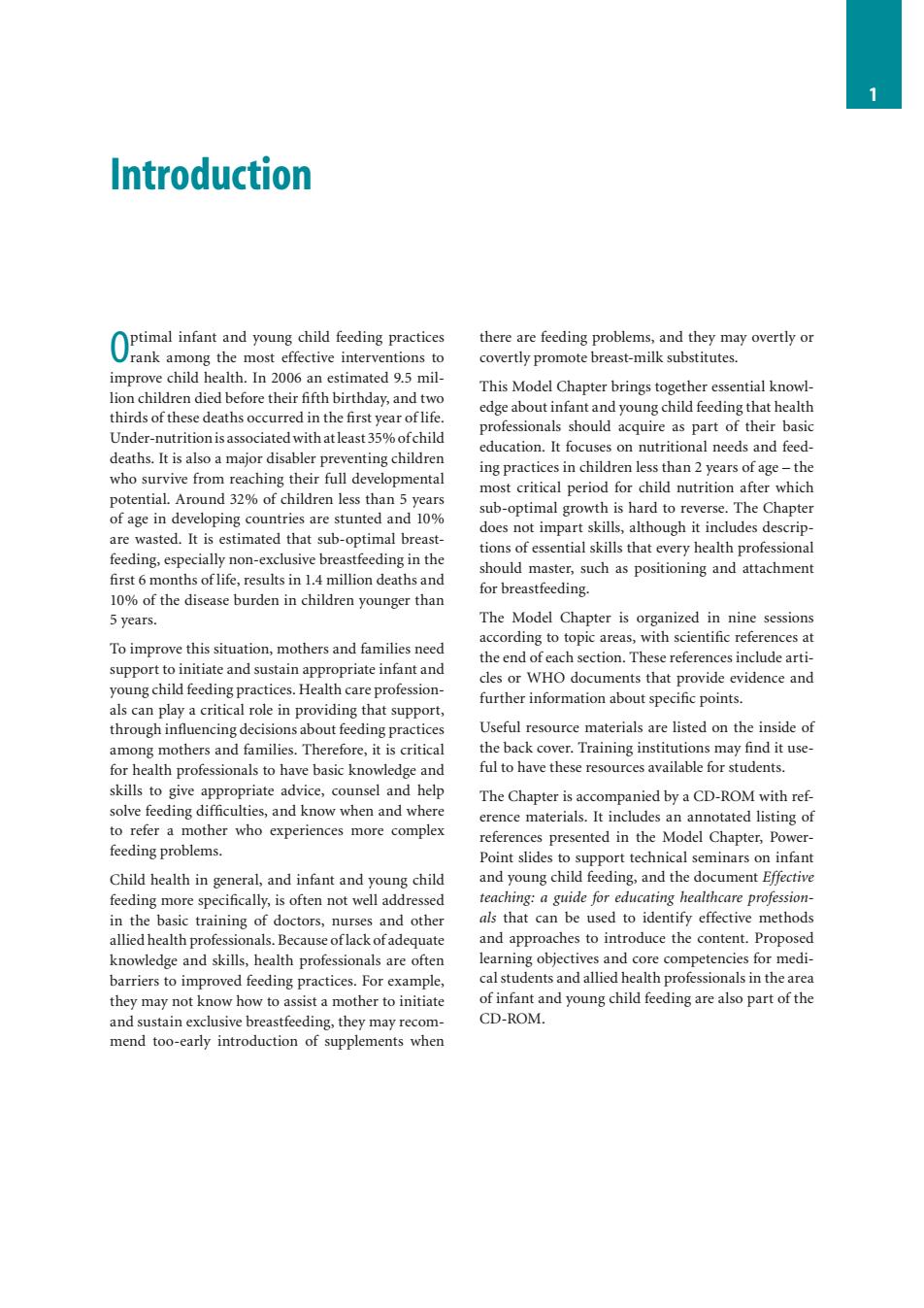正在加载图片...

1 Introduction a the mere there are feeding problems,and they may overtly or covertly promote breast-milk substitutes. improve child health.In 2006 an estimated 9.5 mil- This Model Chapter brings together essential knowl- lion children died before their fifth birthday,and two thirds of these deaths occurred in the first year of life. edge about infant and young child feeding that health Under-nutritionisassociated withatleast 35%ofchild professionals should acquire as part of their basic education.It focuses on nutritional needs and feed- deaths.It is also a major disabler preventing children ing practices in children less than 2 years of age-the who survive from reaching their full developmental most critical period for child nutrition after which potential.Around 32%of children less than 5 years of age in developing countries are stunted and 10% sub-optimal growth is hard to reverse.The Chapter does not impart skills,although it includes descrip- are wasted.It is estimated that sub-optimal breast- tions of essential skills that every health professional feeding,especially non-exclusive breastfeeding in the should master,such as positioning and attachment first 6 months of life,results in 1.4 million deaths and for breastfeeding. 10%of the disease burden in children younger than 5 years. The Model Chapter is organized in nine sessions according to topic areas,with scientific references at To improve this situation,mothers and families need the end of each section.These references include arti- support to initiate and sustain appropriate infant and cles or WHO documents that provide evidence and young child feeding practices.Health care profession- als can play a critical role in providing that support, further information about specific points. through influencing decisions about feeding practices Useful resource materials are listed on the inside of among mothers and families.Therefore,it is critical the back cover.Training institutions may find it use- for health professionals to have basic knowledge and ful to have these resources available for students skills to give appropriate advice,counsel and help The Chapter is accompanied by a CD-ROM with ref- solve feeding difficulties,and know when and where erence materials.It includes an annotated listing of to refer a mother who experiences more complex references presented in the Model Chapter,Power- feeding problems. Point slides to support technical seminars on infant Child health in general,and infant and young child and young child feeding,and the document Effective feeding more specifically,is often not well addressed teaching:a guide for educating healthcare profession- in the basic training of doctors,nurses and other als that can be used to identify effective methods allied health professionals.Because oflack ofadequate and approaches to introduce the content.Proposed knowledge and skills,health professionals are often learning objectives and core competencies for medi- barriers to improved feeding practices.For example, cal students and allied health professionals in the area they may not know how to assist a mother to initiate of infant and young child feeding are also part of the and sustain exclusive breastfeeding,they may recom- CD-ROM. mend too-early introduction of supplements when1 Introduction Optimal infant and young child feeding practices rank among the most effective interventions to improve child health. In 2006 an estimated 9.5 million children died before their fifth birthday, and two thirds of these deaths occurred in the first year of life. Under-nutrition is associated with at least 35% of child deaths. It is also a major disabler preventing children who survive from reaching their full developmental potential. Around 32% of children less than 5 years of age in developing countries are stunted and 10% are wasted. It is estimated that sub-optimal breastfeeding, especially non-exclusive breastfeeding in the first 6 months of life, results in 1.4 million deaths and 10% of the disease burden in children younger than 5 years. To improve this situation, mothers and families need support to initiate and sustain appropriate infant and young child feeding practices. Health care professionals can play a critical role in providing that support, through influencing decisions about feeding practices among mothers and families. Therefore, it is critical for health professionals to have basic knowledge and skills to give appropriate advice, counsel and help solve feeding difficulties, and know when and where to refer a mother who experiences more complex feeding problems. Child health in general, and infant and young child feeding more specifically, is often not well addressed in the basic training of doctors, nurses and other allied health professionals. Because of lack of adequate knowledge and skills, health professionals are often barriers to improved feeding practices. For example, they may not know how to assist a mother to initiate and sustain exclusive breastfeeding, they may recommend too-early introduction of supplements when there are feeding problems, and they may overtly or covertly promote breast-milk substitutes. This Model Chapter brings together essential knowledge about infant and young child feeding that health professionals should acquire as part of their basic education. It focuses on nutritional needs and feeding practices in children less than 2 years of age – the most critical period for child nutrition after which sub-optimal growth is hard to reverse. The Chapter does not impart skills, although it includes descriptions of essential skills that every health professional should master, such as positioning and attachment for breastfeeding. The Model Chapter is organized in nine sessions according to topic areas, with scientific references at the end of each section. These references include articles or WHO documents that provide evidence and further information about specific points. Useful resource materials are listed on the inside of the back cover. Training institutions may find it useful to have these resources available for students. The Chapter is accompanied by a CD-ROM with reference materials. It includes an annotated listing of references presented in the Model Chapter, PowerPoint slides to support technical seminars on infant and young child feeding, and the document Effective teaching: a guide for educating healthcare professionals that can be used to identify effective methods and approaches to introduce the content. Proposed learning objectives and core competencies for medical students and allied health professionals in the area of infant and young child feeding are also part of the CD-ROM